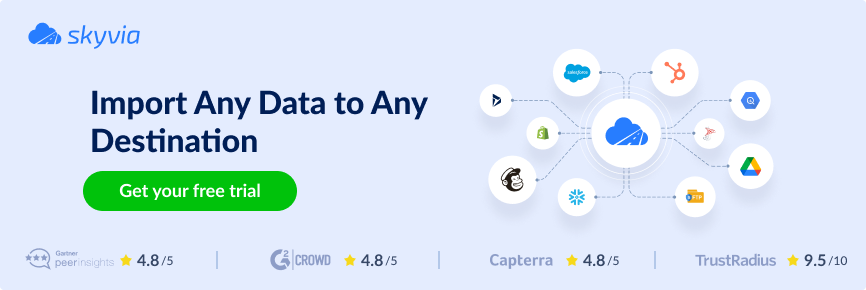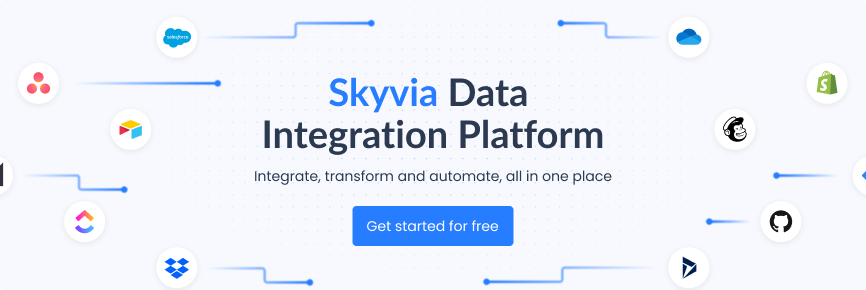Why do modern businesses need ETL (Extract-Transform-Load) tools? They’re drowning in various types of data from apps, websites, CRMs, spreadsheets, etc. The problem? It’s often in different formats and hard to use.
This mess needs behind-the-scenes data wranglers, pulling info from different sources, cleaning it up, and sending it where it needs to go (usually a data warehouse, lake, or some analytics solution).
With the increasing demand for efficient data processing, organizations need ETL tools to quickly and accurately handle massive datasets. However, choosing the right ETL solution for your specific needs can be overwhelming, given the many options available.
This guide discovers the top ETL tools for 2025 to help you compare the latest ones and choose the solution that fits your business requirements.
Table of contents
- What Are ETL Tools?
- ETL in 3 steps
- ETL vs ELT
- Different Types of ETL Tools
- List of Best ETL Tools in 2025
- ETL Tool Comparison
- Factors for Choosing the Best ETL Tool
- Key Considerations for ETL Software Selection
- Conclusion
What Are ETL Tools?
ETL tools are essential for automating and managing moving information between systems. The term ETL stands for extract, transform, and load, and these platforms:
- Extract information from multiple sources.
- Transform it into a valid format.
- Load it into a target system like a DWH.
Instead of manually handling insights, ETL tools connect to databases, pull the information, and ensure it’s ready for analysis or reporting. Such systems provide testing of data pipelines and monitoring of their performance in real-time.
Once set up, such platforms can continue operating smoothly, even if something goes wrong.
Think of them as the backstage crew in a theater production, working tirelessly behind the scenes to ensure that everything is in its place when the curtain rises. These platforms are the invisible hands orchestrating the journey of data from raw, scattered sources to polished, actionable insights in your analytics dashboard.
You don’t have to worry about stepping in every time. The entire process is automatic, saving businesses time dealing with large volumes of data.
ETL in 3 steps
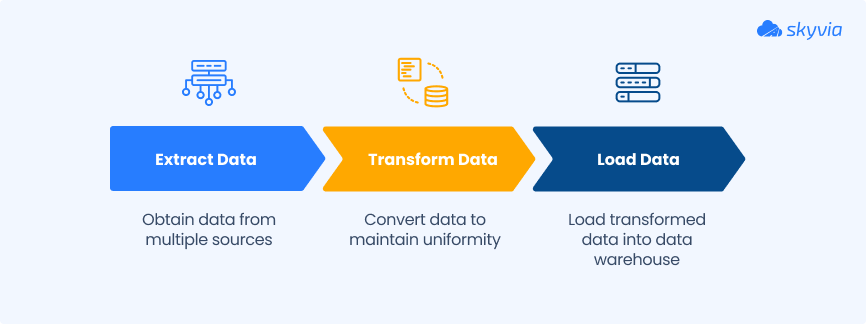
Step 1: Extract
Imagine a journalist collecting interviews, facts, and figures from a variety of databases, cloud apps, spreadsheets, or APIs. ETL tools do the same, automatically gathering data from wherever it lives.
ETL extraction can mean extracting the files generated at a specific location. In such scenarios, a file is created, the information is written into it, and the ETL tool extracts the file from there.
We can extract both structured and unstructured data into the DWH.
Step 2: Transform
Next, just as an editor refines a story, corrects grammar, clarifies meaning, and shapes the narrative, ETL solutions clean, standardize, and enrich the information. They resolve inconsistencies, fill gaps, and convert formats so everything speaks the same language and is ready for analysis.
ETL transformation types include multiple methods like deduplication, joining/splitting, summarization, etc.
Step 3: Load
Finally, picture the finished article published in a newspaper or online. In the data world, this means loading the prepared data into a DWH or business intelligence system, where it’s ready to drive decisions, fuel reports, or power machine learning models.
It can either be loaded all at once, which is commonly called a full load, or at regular intervals, i.e., an incremental load.
Example: Consider an e-commerce company juggling sales data from Shopify, payment records from Stripe, and customer info from a CRM. Manually stitching this together would be a nightmare.
With ETL automation, the company can extract data from all these platforms, transform it to match business rules (like standardizing date formats or categorizing products), and load it into a central dashboard for real-time inventory and sales analytics.
ETL vs ELT
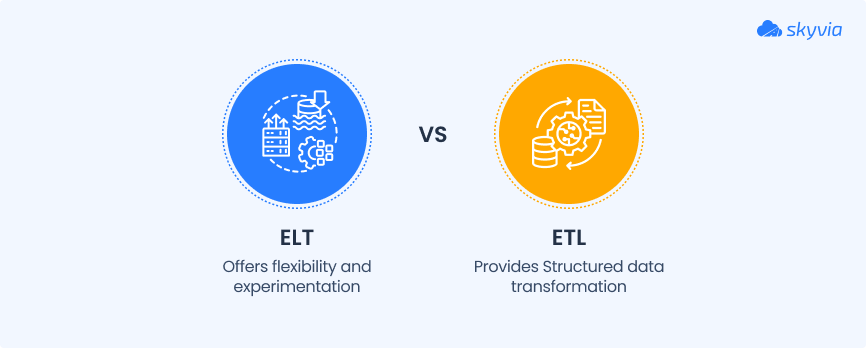
Regarding streamlining processing, ETL (Extract, Transform, Load) and ELT (Extract, Load, Transform) are two common approaches organizations use. While both serve moving insights from one system to another, their workflow, architecture, and when they are best suited for use differ. In many cases, organizations use a combination of both methods depending on the type of info they’re working with.
- Choose ETL if you need to apply complex transformations, clean and validate insights before loading them into your destination, or if your storage system can’t handle heavy processing tasks. It’s perfect for smaller datasets or when working with legacy systems.
- Choose ELT if you’re dealing with large volumes of information, cloud-based systems, or need faster loading with transformations happening after the data is loaded. ELT is often more scalable and efficient for modern insights environments.
ELT (Extract-Load-Transform)
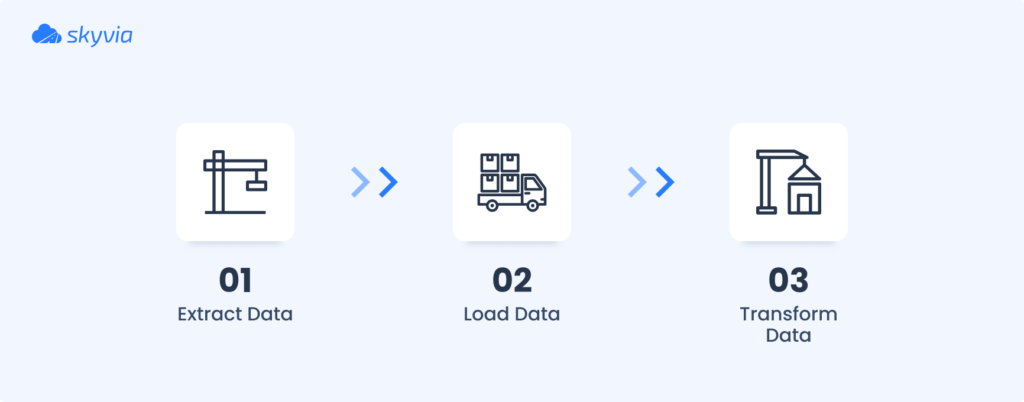
Data is extracted from the source system and loaded directly into the target system (usually a warehouse) without transforming it beforehand.
Once it’s loaded, transformations are applied within the DWH. This method allows users to store raw, untransformed information in the DWH, which is more flexible for experiments with different transformation strategies as needed.
Pros
- Faster Loading. Since data is loaded directly into the DWH before transformation, the loading process is typically faster, making it ideal for large datasets.
- Flexibility in Transformation. Storing raw information gives you the flexibility to apply different transformation strategies as you go, enabling more dynamic and ad-hoc transformations.
- Scalable for Big Data. ELT is well-suited for cloud-based data warehouses (like Google BigQuery, Snowflake, or Amazon Redshift) and is designed to handle large-scale transformations efficiently.
- Simplified Automation. By separating the extraction and loading processes from transformation, automation becomes easier. You don’t need to worry about transforming insights in real-time.
- Cost-Efficiency for Cloud Platforms. With modern cloud DWHs offering scalable compute resources, ELT can be more cost-effective for businesses with high volumes of info.
Cons
- Higher Storage Requirements. Storing raw, untransformed data means you’ll need more storage space in the DWH, which can lead to higher costs for storage.
- Potential Data Privacy Risks. Raw data may contain personal or sensitive information, which can pose privacy and security risks if not handled properly, especially in industries with strict data protection regulations.
- Slower Transformations. Although loading is faster, transformations occur after data is in the warehouse, resulting in slower performance when you need to analyze it quickly.
- Complexity in Data Management. Having raw data stored in the warehouse might make managing and cleaning it harder, especially if the transformation process is complex or inconsistent.
- Requires Powerful Computing Resources. Cloud-based warehouses or on-premise systems need robust computing power to handle large-scale transformations efficiently, adding to operational costs.
Different Types of ETL Tools
There are various ETL solutions available in the market. Some organizations use them in big data analysis, writing SQL scripts for the same. These ETL platforms can also be used for business intelligence.
ETL tools can be categorized based on their usage and cost.
Among the different types of ETL systems are the following:
Cloud-based ETL tools
Such systems are like ride-share apps: you don’t need to own a car or worry about maintenance. Just tap a button, and a car (ETL pipeline) arrives, ready to take the data wherever it needs to go. Solutions such as Skyvia, Fivetran, or Stitch are scalable, managed, and integrate easily with cloud services.
Example:
An online retailer uses Skyvia to automatically extract customer data from its website, transform it for analysis, and load it into a cloud DWH. If traffic spikes during a sale, the tool scales up automatically, just like rideshare surge pricing ensures enough cars are available when demand is high.
Open-source ETL tools
Think of them as a community bike workshop. You get the basic tools and blueprints for free and can customize your bike (data pipeline) however you like. Tools like Talend Open Studio and Pentaho Data Integration are flexible and cost-effective, perfect for organizations with technical teams who enjoy tinkering and tailoring their solutions.
Example:
A startup uses Talend Open Studio to pull sales data from its e-commerce site, transform it to match its accounting system, and load it into a cloud database. The open-source nature lets them add custom connectors as their business grows, like adding new gears to their bike for different terrains.
Enterprise software tools
Imagine a big train moving containers across the country. Systems like Informatica PowerCenter or Oracle Data Integrator are built for heavy loads, complex routes, and strict schedules. They’re robust, fast, and packed with features, ideal for large corporations moving huge volumes of info between many systems. Their top priorities are reliability and speed.
Example:
A global bank uses Informatica PowerCenter to integrate customer transactions from dozens of countries. The tool’s parallel processing and automated failure detection ensure that even if one “car” (data source) has an issue, the rest of the train keeps moving, and issues are flagged for quick repair.
Reverse-ETL tools
Reverse ETL refers to the process of syncing/copying the data from the DWH to the other operational tools that are being used by the business teams.
In other words, it is the opposite of the ETL or ELT process, where the data flows into the warehouse.
Such systems (e.g., Hightouch, Census, Polytomic, Rudderstack, Grouparoo) automate extracting curated data from your DWH, transforming it to match the needs of operational systems, and loading it into platforms like CRMs, marketing automation, or customer support tools.
Example:
Imagine a marketing team identifying high-value customer segments in their data warehouse. With reverse ETL, these segments are automatically synced to their email marketing platform. When a customer makes a new purchase, the warehouse updates, and the marketing system instantly knows to stop sending them retargeting ads.
Real-Time ETL tools
These are like an airport’s air traffic control tower. They monitor, process, and direct streams of incoming and outgoing flights (data) in real time. Unlike batch ETL, which processes data in scheduled intervals, real-time ones handle data the moment it “takes off” or “lands,” ensuring immediate visibility and action. This approach is crucial for scenarios where delays could mean missed opportunities or risks, such as fraud detection, stock trading, or live customer analytics.
Example:
Imagine a global e-commerce company during a major sales event. As customers place orders, update carts, or request support, real-time ETL tools instantly capture these actions from websites, mobile apps, and payment gateways. The tools transform this insight into dashboards for live inventory tracking, fraud detection systems to flag suspicious transactions within seconds, and customer support platforms to provide up-to-the-moment order status.
Custom ETL tools
Some organizations build ETL solutions, like a custom Swiss Army knife. You design each blade and tool to meet your exact needs. These are often scripts or in-house platforms, perfect for unique requirements or when off-the-shelf tools just won’t do.
Example:
A logistics company with legacy systems writes custom Python scripts to extract shipment data, transform it for modern analytics, and load it into a new dashboard. This approach gives them complete control but requires skilled developers to maintain and upgrade the “knife” as new needs arise.
List of Best ETL Tools in 2025
Skyvia
Skyvia is a robust cloud-based SaaS (Software as a Service) platform offering integration, replication, sync, cloud backup, data flow, and control flow solutions.

It supports over 200 connectors, making it easy to integrate data from various cloud applications, databases, file storage services, and cloud DWHs.
Skyvia’s ETL tool allows users to perform data extraction, transformation, and loading (ETL), ELT, and reverse ETL processes, all without coding.
Its user-friendly interface and cloud-based nature make it an attractive option for businesses of all sizes, as it requires no local installation and works directly from the web browser.
Pros
- Free trials and plans are available to test features before committing.
- A no-code interface simplifies complex tasks like data transformations and queries.
- Scheduled package runs and automatic monitoring for smooth, continuous operations.
- Failure alerts and detailed logs ensure users stay on top of their integrations and troubleshoot issues quickly.
- Easy setup and intuitive interface for both technical and non-technical users.
Cons
- Limited functionality on the free plans, with some features and connectors restricted.
- No streaming data source support for real-time integrations.
- It might not meet the needs of highly complex custom integrations or very specific data processing requirements.
Pricing
Skyvia offers several flexible pricing plans based on the features and usage requirements.
A free plan with limited features and usage makes it ideal for small projects or testing purposes. Paid plans start from $79/month and scale depending on the number of integrations, data volume, and advanced features required (e.g., API access, custom connectors, etc.).
Pentaho
It’s an open-source integration and analytics platform widely used for ETL processes, data blending, and advanced analytics.
It allows users to extract, transform, and load the information from various databases, applications, and flat files.

Pentaho provides enterprise-grade capabilities and an open-source community edition, giving businesses flexibility in choosing the solution that fits their needs.
With its powerful integration tools, Pentaho can process data at scale and offers deep analytics capabilities, including reporting, dashboards, and predictive analytics.
The platform’s intuitive, drag-and-drop interface and the ability to create complex workflows make it a popular choice for technical and non-technical users.
Pros
- Open-source version available for cost-effective data integration.
- Wide support for data sources and integration capabilities, including cloud services, databases, etc.
- Flexible transformation options for complex data manipulation and processing.
- Scalable architecture suited for both small and large data environments.
- Provides advanced analytics, including reporting, dashboards, and predictive capabilities.
Cons
- Requires technical expertise to set up and manage, especially for more complex transformations.
- Performance issues when working with huge datasets.
- The user interface can feel less intuitive compared to some more modern tools.
- Limited cloud-native features compared to cloud-first platforms.
Pricing
Pentaho offers both free and paid options. The Community Edition is free and open-source, ideal for small to medium-sized businesses or those with a limited budget. The Enterprise Edition is priced upon request and includes additional support, scalability, and advanced features like high availability and extended connectors. For precise pricing, especially for the Enterprise Edition, contacting Pentaho directly is best to receive a customized quote based on your business requirements.
Oracle Data Integrator
This integration tool supports ETL and ELT processes across various data sources. It provides an open, standards-based approach to integrate data from multiple databases, cloud applications, and other sources into Oracle databases and other platforms.
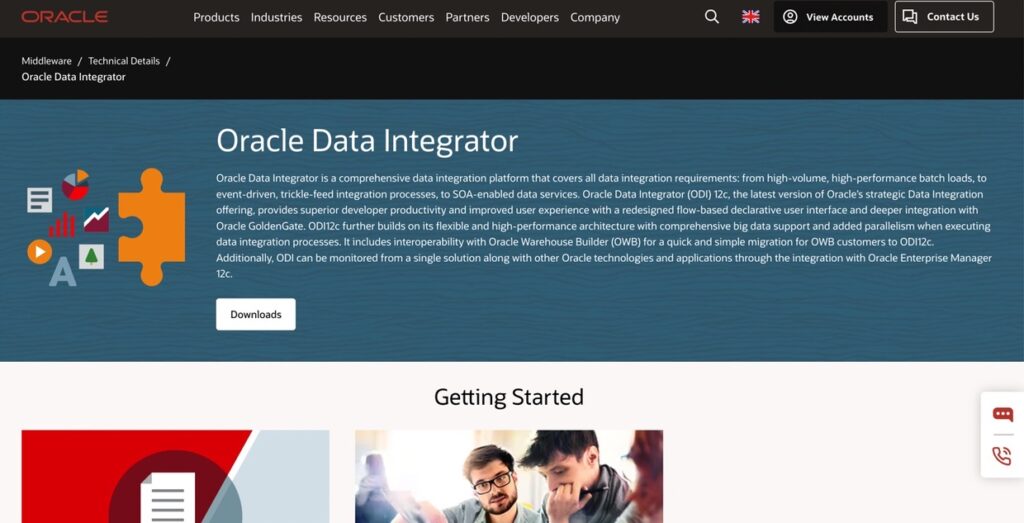
ODI offers high-performance transformations, real-time integration, and advanced data quality capabilities. Large enterprises widely use it for data migration, warehousing, and real-time analytics.
Pros
- High-performance ETL and ELT processing, especially with large datasets.
- Real-time data integration with minimal latency is ideal for businesses requiring up-to-date data.
- Support for a wide range of data sources, including databases, cloud services, and big data platforms.
- Advanced data transformation capabilities that allow complex data manipulation.
- Comprehensive data quality features to ensure clean, reliable data.
Cons
- Requires Oracle infrastructure, making it less suitable for non-Oracle environments.
- Complex setup and management typically require technical expertise and specialized knowledge.
- Higher cost compared to some open-source and cloud-based ETL tools.
- Limited community support compared to other more widely adopted tools.
Pricing
ODI has no fixed pricing model and offers custom pricing based on deployment size and business needs. The cost will typically include both licensing and support fees. For the most accurate pricing, it’s best to contact Oracle directly or visit their website to request a quote tailored to your organization’s needs.
Talend Open Studio
It’s an open-source ETL and integration platform that provides businesses with a wide range of data processing and transformation capabilities.
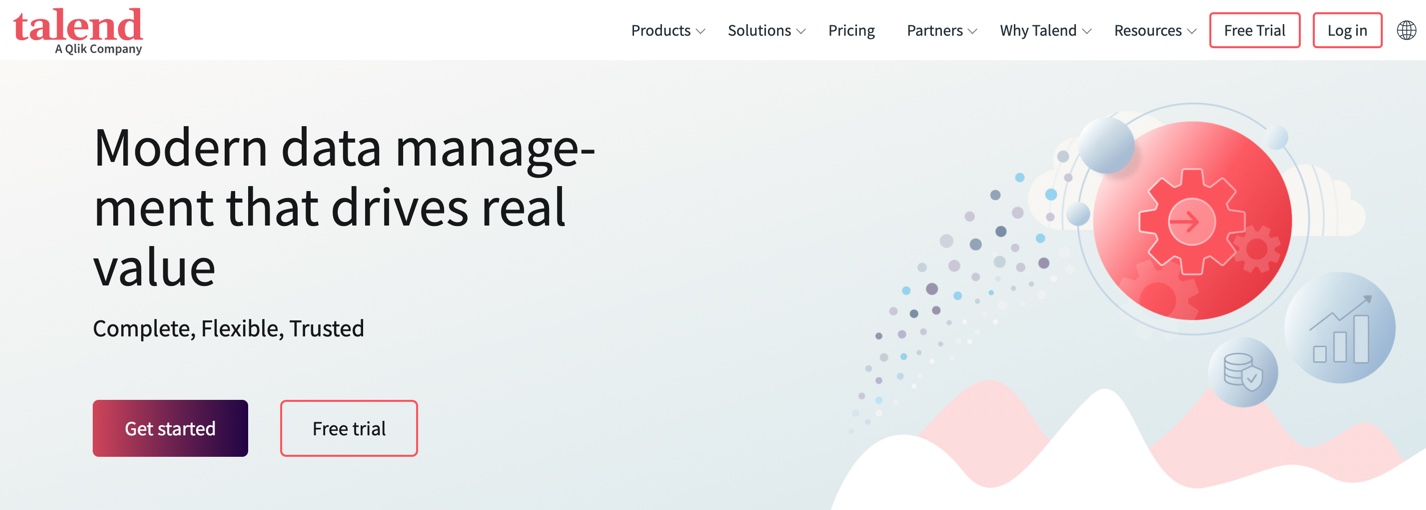
It enables users to extract, transform, and load data from multiple databases, cloud services, and flat files.
Its drag-and-drop interface allows even non-technical users to design and execute data workflows.
The tool also supports integration with other Talend products for more advanced features, making it a flexible option for small to medium-sized businesses or those looking to scale their data integration efforts.
Pros
- Open-source and free to use, making it a cost-effective choice for businesses on a budget.
- A broad range of connectors supporting integration with various databases, cloud services, and applications.
- Flexibility to scale as businesses grow, with the ability to integrate additional Talend products for advanced features.
- Strong community support, offering extensive documentation and resources for users.
- Easy to use for developers familiar with the Eclipse IDE.
Cons
- It requires technical knowledge to set up more complex transformations and workflows.
- Performance can lag with larger datasets or complex integrations.
- Limited cloud-native features, especially compared to newer, cloud-first tools.
- It may require additional plugins or Talend Enterprise products for advanced capabilities like big data processing.
Pricing
The free and open-source platform offers robust features without licensing fees. However, if you need additional features such as advanced support, big data integration, or cloud connectivity, Talend offers paid plans as part of its Talend Data Fabric suite. The enterprise-level pricing depends on the scale of the deployment and the specific capabilities users need, so it’s recommended to contact Talend for a custom quote.
Informatica PowerCenter
This enterprise-grade integration platform handles complex ETL workflows. It enables businesses to extract, transform, and load information from various sources into DWHs, cloud platforms, and other target systems.
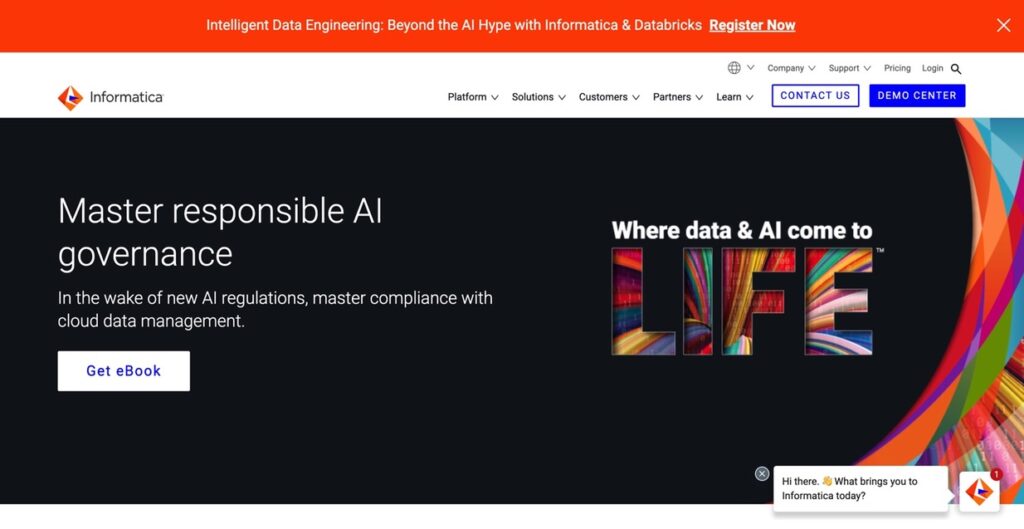
The platform supports high-volume data processing and is used by large enterprises for data migration, quality management, and governance. With advanced transformation, scheduling, and error-handling features, Informatica PowerCenter is well-suited for organizations that require sophisticated data integration solutions at scale. It offers a graphical user interface for designing workflows and monitoring tools to track job performance and troubleshoot issues.
Pros
- Advanced data transformation capabilities, enabling sophisticated data processing and cleansing.
- Comprehensive monitoring and debugging tools to ensure smooth operations.
- Supports many data sources, including cloud, on-premise, and hybrid environments.
- Strong data governance features help ensure compliance with regulations.
- It supports parallelism and easy job scheduling.
Cons
- It is expensive, particularly for small businesses or those with budget constraints.
- Requires specialized knowledge for setup, maintenance, and complex transformations.
- Complex user interface might be challenging for new users or non-technical teams.
- Performance can suffer when handling very large datasets without sufficient hardware.
Pricing
Informatica PowerCenter offers custom pricing based on the deployment size, number of users, and the required features.
The pricing can be higher, making it more suitable for large enterprises with complex data integration needs. For detailed pricing, contact Informatica directly to receive a tailored quote for your business needs.
Fivetran
This cloud-based data integration system provides automated ETL and ELT services to move data between various sources and destinations. It simplifies the process by automating data pipelines and offering pre-built connectors for a wide range of applications and databases.
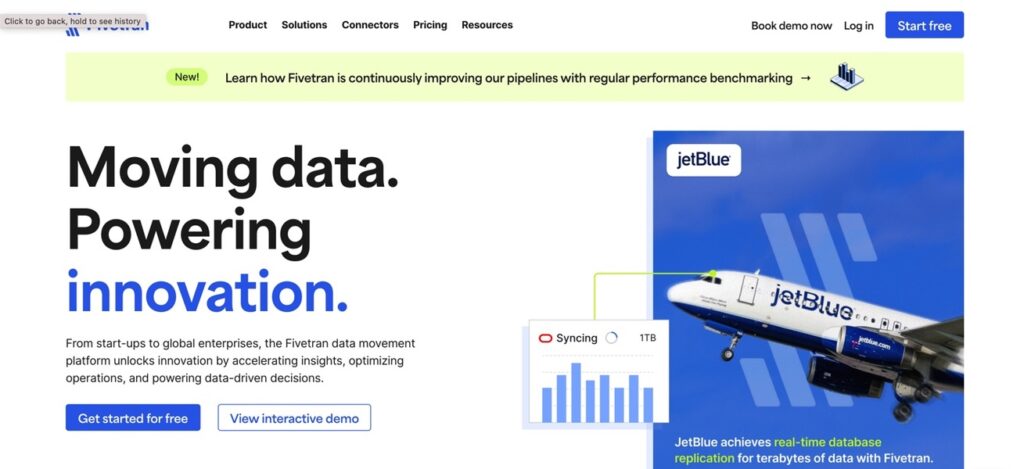
Fivetran is designed for seamless data extraction, transformation, and loading with minimal setup and ongoing maintenance.
It’s particularly known for its ability to handle high-volume, high-frequency data transfers.
It is the right choice for those looking to streamline their data workflows and maintain clean, synchronized data across platforms.
Pros
- Over 500 pre-built connectors, making it easy to integrate with various platforms.
- Automatic schema migrations and incremental data loading ensure up-to-date data.
- Minimal maintenance is required. Fivetran takes care of data pipeline management.
- Fast setup with no code needed, making it ideal for non-technical users.
- Scalable and can handle high-frequency data transfers for large datasets.
Cons
- It is expensive compared to some other ETL tools, especially at scale.
- Limited transformation capabilities compared to more advanced ETL tools.
- Data source restrictions, not all platforms are supported.
- It can be difficult to troubleshoot in case of issues with data sync.
Pricing
Fivetran offers custom pricing, with costs based on the volume of data and connectors in use. The base plan starts at $1,000/month and can increase depending on the data usage and specific needs. For detailed pricing, contact Fivetran directly for a personalized quote.
Stitch
This cloud-based ETL service simplifies data integration and transfer between various data sources and destinations. It’s easy to use and provides pre-built connectors for over 130 platforms, making it easy to extract, transform, and load data with minimal configuration.
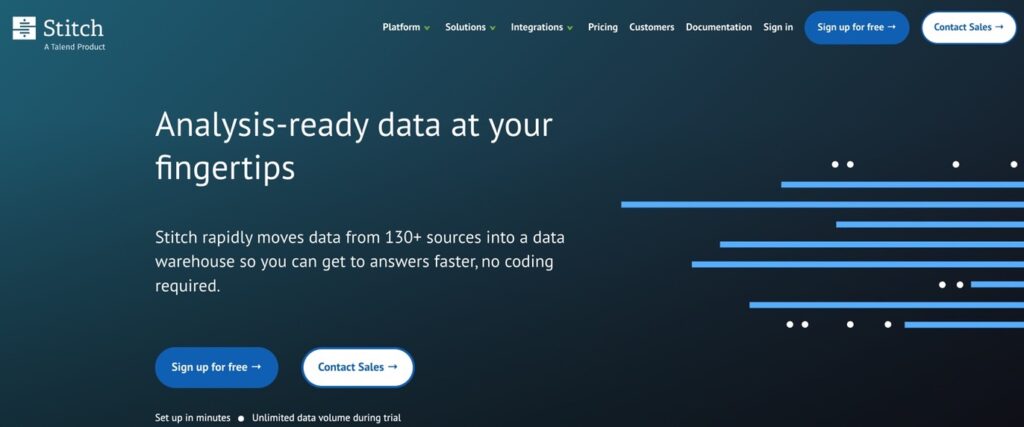
Stitch offers automated, reliable data pipelines with built-in scheduling, allowing businesses to focus on analytics while it handles the heavy lifting.
The platform is a good solution for businesses looking to integrate and manage data across multiple cloud applications without extensive technical expertise.
Pros
- 140+ pre-built connectors, simplifying integration with a wide range of platforms.
- Automated scheduling of data pipelines, reducing the manual work for data engineers.
- Scalable solution for both small businesses and larger enterprises with growing data needs.
- Easy-to-use interface with a simple setup process and minimal technical requirements.
- Real-time data replication for most sources, ensuring up-to-date data in the DWH.
Cons
- Limited transformation capabilities compared to some other ETL platforms.
- No on-premise options, Stitch is cloud-based only, which might not work for some organizations.
- It can get expensive as the data volume grows or when using premium connectors.
- Basic error handling, some users report limited troubleshooting options when data fails to sync.
Pricing
Stitch offers a free plan with basic functionality for small datasets.
Paid plans start at $100/month and increase depending on the data processed and the number of connectors used.
Pricing is based on the number of rows synced per month, and additional features like advanced connectors or support come with higher-tier plans.
Airbyte
This open-source integration platform executes automated ELT pipelines along with monitoring their logs. It focuses on providing a flexible and scalable solution with over 550 pre-built connectors, making it easy to integrate with a variety of cloud applications, databases, and DWHs.
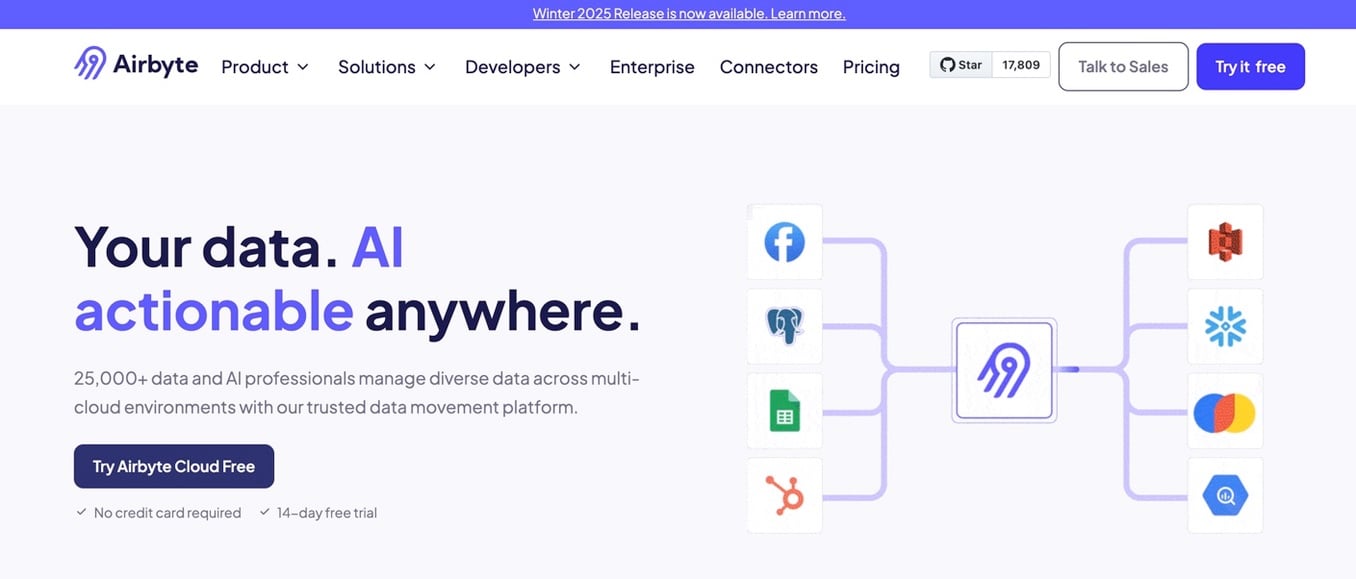
One of Airbyte’s key advantages is its open-source nature, which gives users the ability to customize and extend the platform according to their specific needs. It also offers automatic schema migrations, ensuring that your data pipelines are always up-to-date without manual intervention.
Pros
- Open-source and free to use, allowing for customizations and no licensing fees.
- Flexibility with the ability to customize connectors and transformations.
- Active community support and regular updates from Airbyte contributors.
- Cloud-native and scalable, ideal for small and large businesses with growing data integration needs.
Cons
- Limited support for data transformation, Airbyte focuses more on data extraction and loading, leaving transformations to other tools or custom coding.
- Setup and maintenance may require technical expertise, especially for customization.
- Still evolving as an open-source project, some features may not be as polished as those of more mature platforms.
- It requires monitoring, and users must manage data pipelines and ensure smooth execution.
Pricing
Airbyte offers free open-source access and enterprise-level features with premium support and additional capabilities.It provides custom pricing based on organizations’ business requirements and usage for advanced features and dedicated support.
Singer
It’s a Python-based open-source tool that allows data extraction from different sources and consolidation to multiple destinations.
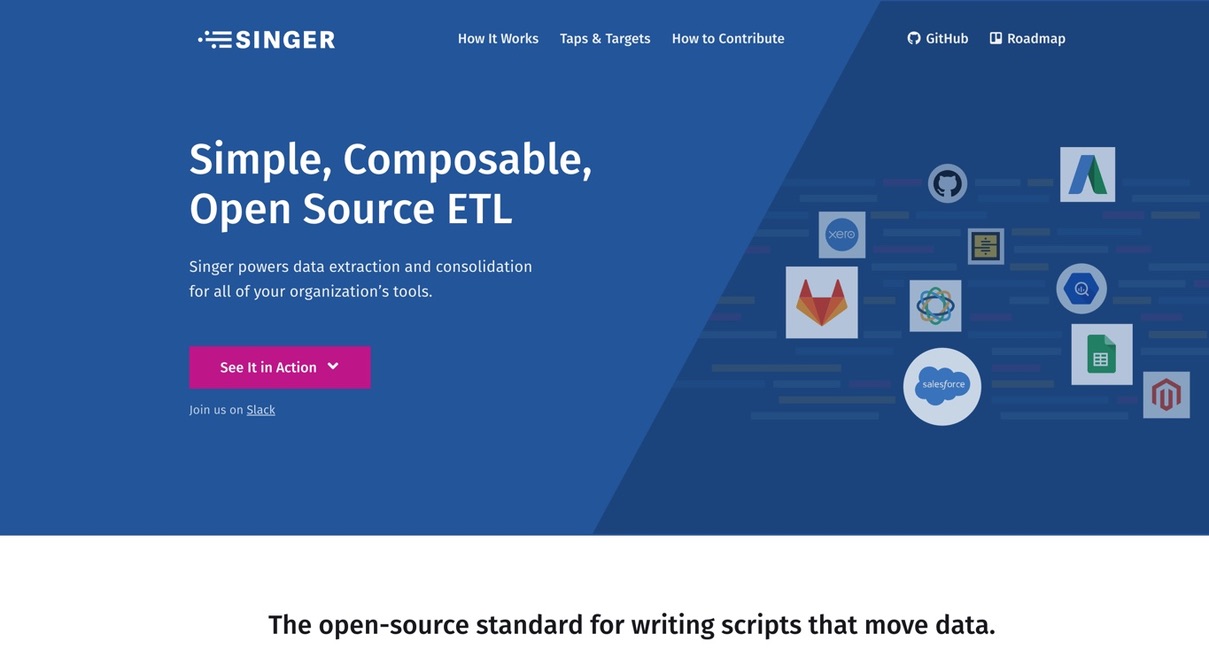
Instead of being a complete ETL tool itself, Singer focuses on offering standardized connectors called “Taps” (for extracting data) and “Targets” (for loading data).
It allows users to easily create custom connectors or use pre-built ones to integrate data from a variety of sources into their target systems. Singer is a fine choice for developers who prefer a modular, code-first approach, providing great flexibility in handling and processing data.
Pros
- Open-source and free to use, making it an affordable option for businesses.
- Modular design with reusable “Taps” and “Targets” for flexible data integration.
Customizable connectors, developers can create their own taps and targets as needed.
Active community and extensive documentation for support.
Supports a wide range of sources and destinations, enabling seamless integrations.
Cons
- It requires development expertise, as it’s primarily designed for developers and data engineers.
- Limited built-in transformation capabilities; users need to build their own logic or integrate with other tools for transformations.
- It is not a fully managed solution, so it requires more effort in setup and maintenance compared to cloud-based ETL platforms.
- Lack of a native UI, as it’s a code-first platform, there’s no easy drag-and-drop interface for non-technical users.
Pricing
Singer is completely free and open-source, with no licensing fees or subscription costs.
However, if you require additional enterprise-level support or features, you may need to integrate it with other tools or services that come at a cost.
Xplenty (Integrate.io)
This cloud-based ETL system offers a friendly interface that allows users to create data pipelines without the need for coding expertise quickly.
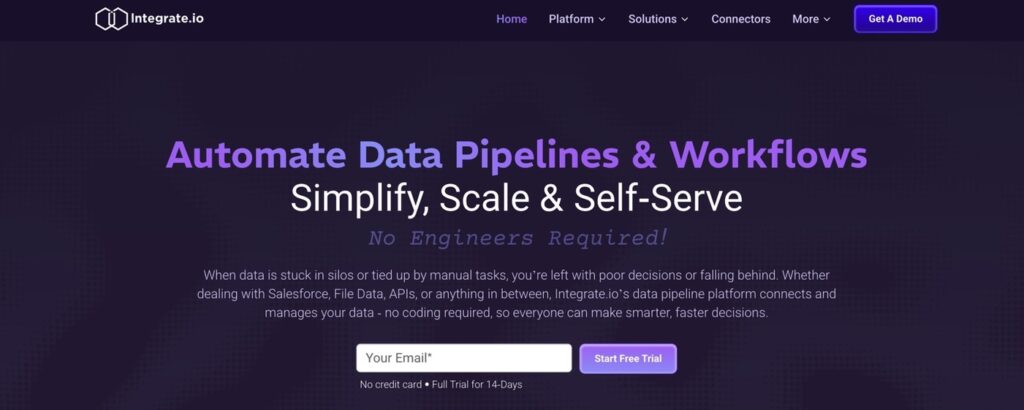
It supports a wide range of integrations, from cloud sources, SaaS apps, and databases to DWHs, making it a versatile choice for businesses looking to streamline their data workflows. Xplenty also provides real-time data processing and automated scheduling, enabling companies to ensure their data is always up-to-date for analytics.
Pros
- A no-code interface makes it easy for non-technical users to build and manage data pipelines.
- Scalable for businesses of all sizes, with support for real-time data processing.
- Automated scheduling of ETL processes, reducing manual intervention and improving efficiency.
- Customizable transformation and data processing capabilities for more advanced users.
Cons
- It can become expensive at scale, especially with high data volumes or large numbers of integrations.
- Limited transformation options for complex data manipulations compared to more advanced tools.
- It may require additional configuration for specific connectors, particularly for non-standard data sources.
- It is not as flexible as some open-source alternatives regarding custom integrations.
Pricing
The custom pricing is based on the size of the data and the specific features required. It typically starts from around $99/month for small to medium businesses and increases based on the number of data sources, destinations, and advanced features like real-time processing.
ETL Tool Comparison
When choosing the right ETL tool, it’s essential to consider factors like:
- Pre-built connectors.
- Ease of use (no-code/low-code).
- Deployment options.
- Key features.
Each tool offers a different balance depending on users’ business needs, data complexity, and scalability requirements.
This table compares key ETL tools based on such criteria.
| Tool | Type | Pre-built Connectors | Usability | Deployment | Key Features |
|---|---|---|---|---|---|
| Skyvia | Cloud-based | 200+ | No-code. User-friendly, intuitive interface. | Cloud | Data integration, ETL, ELT, reverse ETL, backup, replication, sync, data flow, control flow. |
| Pentaho | Enterprise | 100+ | Low-code. Technical, powerful features. | On-premise | Data integration, big data, analytics, and real-time processing. |
| Oracle Data Integrator | Enterprise | 100+ | Low-code. Complex setup, high performance. | On-premise | High-performance ETL/ELT, real-time integration, and data governance. |
| Talend Open Studio | Open-source | 100+ | Low-code. Developer-focused, flexible. | Cloud, On-premise | Data transformation, cloud-native, batch processing. |
| Informatica PowerCenter | Enterprise | 200+ | Low-code. Complex, powerful, robust. | On-premise | High-volume data processing, real-time integration, data governance. |
| Fivetran | Cloud-based | 500+ | No-code. Easy setup, minimal maintenance. | Cloud | Real-time data replication, automated schema migrations. |
| Stitch | Cloud-based | 140+ | No-code. Easy to use, suitable for small datasets. | Cloud | Automated data syncing, real-time replication. |
| Airbyte | Open-source, cloud | 550+ | Low-code. Developer-centric, customizable. | Cloud, On-premise | Custom connectors, real-time data integration. |
| Singer | Open-source | 100+ | Low-code. Developer-focused, flexible. | Cloud, On-premise | Modular, customizable, supports custom connectors. |
| Xplenty (Integrate.io) | Cloud-based | 100+ | No-code. Intuitive, scalable. | Cloud | Data processing, integration, real-time sync, flexible transformations. |
Factors for Choosing the Best ETL Tool
Selecting the right ETL software is like outfitting your team for a cross-country expedition. Each factor you consider is a piece of gear that ensures the journey through the data landscape is smooth, efficient, and free of unpleasant surprises.
When choosing the best ETL tool:
- Check how well it works with the sources and where you plan to send the information.
- Users without deep tech knowledge may need a system that’s easy to use and intuitive.
- Speed and performance also matter when handling big chunks of data.
- Check the cost and ensure it fits the company’s budget, including any hidden fees.
- See what kind of support and community are behind the tool.
- Finally, check if it scales with you as the data grows.
Key Considerations for ETL Software Selection
- Compatibility: The Universal Travel Adapter. As you pack an adapter to connect your devices anywhere in the world, your ETL system must plug seamlessly into all the data sources and destinations: cloud warehouses, SaaS apps, or legacy databases. The more pre-built connectors and integrations it offers, the less time you’ll spend wrestling with custom setups.
- Ease of Use: The All-Terrain Vehicle. Some expeditions require expert drivers, while others benefit from vehicles anyone can handle. A user-friendly solution with no-code or low-code options lets technical and non-technical team members build, monitor, and adjust data pipelines, so you don’t need a specialist at every turn.
- Scalability & Performance: The Expandable Backpack. As your journey progresses, you’ll collect more “supplies” (data). The ETL software should be able to handle growing volumes and complexity without slowing down, much like a backpack that expands to fit new gear. Look for tools that can process large datasets quickly and reliably and scale up as your business grows.
- Transformation Capabilities: The Swiss Army Knife. Every adventure needs a tool that can adapt to unexpected challenges. The best platforms offer robust transformation features, handling everything from simple data cleaning to complex business logic, so you’re ready for whatever the data throws at you.
- Cost: The Trip Budget. No journey is complete without a budget. ETL tools come with a variety of pricing models, like subscription, pay-as-you-go, or open source. Ensure the costs align with your needs, and you won’t be hit with surprise fees as the data grows.
- Support and Community: The Expedition Guide. When you hit a rough patch, it helps to have an expert guide or a community of fellow travelers. Consider the quality of vendor support, documentation, and active user communities to ensure you’re never stranded when issues arise.
- Security and Compliance: The Sturdy Lockbox. Protecting the data is like keeping your valuables in a lockbox. Ensure the system offers strong security features, encryption, and compliance with regulations like GDPR or HIPAA, especially if you’re handling sensitive information.
- Flexibility and Customization: The Modular Toolkit. Every expedition is unique. The right software should let you customize workflows, transformations, and scheduling to fit your organization’s distinct requirements, whether you need real-time streaming, batch processing, or both.
Conclusion
The ETL tools are a perfect way for organizations to streamline and maintain the data pipeline, data governance, and monitor these processes daily. Choosing the right ETL tool for you depends on multiple factors like the use cases of the organizations, connection to the data sources, skill sets for using the application, ability to provide role-based access and data governance, budget, etc.
The open-source ETL tools are free, but certain expertise is required to develop and maintain the workflows.
In the segment of cloud-based ETL tools, Skyvia excels by providing essential features that meet the demands of modern data integration, making it an excellent choice for businesses looking to streamline their data management processes.
F.A.Q. for Best ETL Tools
What types of ETL tools are there?
ETL tools include cloud-based (Skyvia, Fivetran), on-premise (Informatica, Talend), and open-source (Apache Nifi, Airbyte), each serving different business requirements for integration, customization, and security.
How do I choose the best ETL software for my business?
Consider data volume, processing needs, and scalability. Cloud-based tools like Skyvia are user-friendly, while on-premise tools like Informatica offer better security control for sensitive industries.
What are the top ETL tools for large-scale data migration?
For large-scale migrations, Informatica PowerCenter and Talend Data Fabric handle high volumes efficiently, while Fivetran and Skyvia are ideal for cloud-based migrations with strong scalability.
What is the difference between batch ETL and real-time ETL tools?
Batch ETL processes data in scheduled intervals, while real-time ETL tools (e.g., Fivetran, Airbyte) offer continuous updates. Choose based on the need for immediate data consistency and speed.

